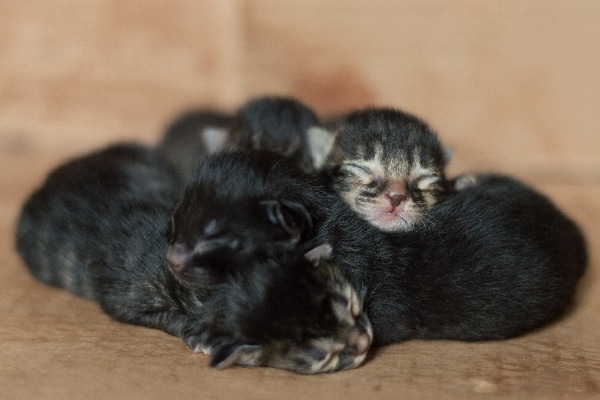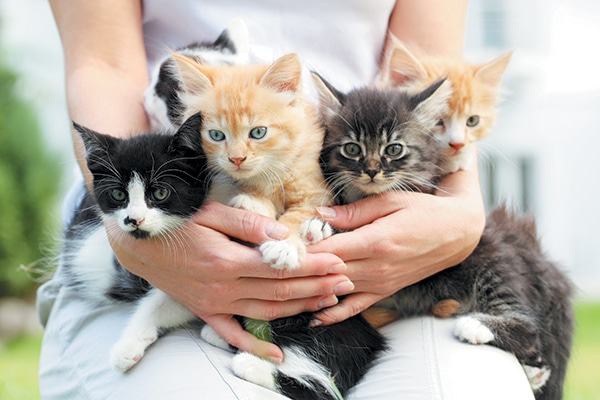The range of blues we see in cats' eyes is the result of refracted light, rather than a function of pigmentation. Although we perceive this color in a cat's eye as blue, it is not a color in itself, but a lack of color combined with refraction of light. What produces other eye colors in cats is the degree of transparency of the outer eye as well as the pigment available in the cat's iris. Let's answer the question "When do kittens' eyes change color" and give an overview of how and why kittens' eyes change color.

Kitten Eyes: What you need to know about the first month
The first step to answer the question "When do kittens' eyes change color" is to know that their eyes are not even open at birth. When leaving the uterus and entering the birthing box, the eyes of a newborn kitten are closed tightly and are of no use anymore. Just like their hairless body and closed ears, a kitten's eyes are not fully developed at birth. The only senses that function from birth are those of touch and smell. With the help and protection of its mother, a kitten is able to eat and sleep. These activities provide the fuel and raw materials necessary for general growth, including preparing the eyes for vision.
Each kitten develops at a different rate, but in general, a kitten's eyes are mature enough to open during the second week of life, between 7 and 14 days after birth. Once the eyelids begin to separate, it may take two or three days for them to open completely. Even then, open does not mean functional. Part of kittens' eye maturation is developing the ability to process light and interpret sensory data.
During the first month to five weeks, a kitten can see about as well as Han Solo just out of his carbonite prison in the Return of the Jedi, when everything appeared as a "blur of light". Just like Han Solo, who stumbled a bit at first, eye-hand - or eye-pattern coordination is most likely still a work in progress for a kitten. Most kittens will reach full eye and visual function at some point between weeks 5 and 7.

So, when do the kittens' eyes change color?
During this developmental period, a baby kitten learns to see, but her eyes will not be fully mature - including their adult coloring - until 3 to 6 months of age. For kittens, it's vision first, color second. During the first few weeks after a kitten's eyes are opened, they will appear blue. This hue is the effect of light refracted by the cornea, the transparent outer cover of the eyeball and the relative thickness of its four layers. As the color of a cat's eye matures, our perception of it continues to be affected and influenced by this blue or blue-green refracted outer covering.
So when do kittens' eyes change color? At the 6th or 7th week of age, a kitten's eye color begins to change. The iris, the colored part of the eye, contains melanocytes. Once the eye is mature enough, these melanocytes begin to produce melanin, the pigment that gives the eye its mature adult color. The number of melanocytes and the amount of melanin they produce determine the final color and its depth or intensity. On the spectrum we mentioned above - green at one end and brown at the other - light green means that a cat's iris has produced the smallest amount of melanin, and brown the largest.
Exceptions: blue-eyed and odd-eyed cats
There are exceptions to the question "When do kittens' eyes change color?". - including adult cats with blue eyes and cats with iridum heterochromia, or two eyes of different colors. Cats that retain blue eyes in adulthood do so because of low or no melanin production. Examples include colorpoint cats, such as Siamese, and breeds that have developed with Siamese as the main genetic contributor. Among these are :
Like their fascinating distribution of fur colors, the blue eyes of colorpoint cats are the result of a form of partial albinism. In these cats, the blue eyes, just like the limited coat color, are due to a limited melanin content. Adult blue-eyed cats are also typical of Ojos Azules, and in much deeper and darker shades than those usually seen in melanin-deficient colorpoint breeds.
For white-haired cats and some bicolor cats, blue eyes in adulthood may be the result of genes that suppress or mask other pigments, rather than a simple absence of them. While the blue eyes of colorpoint cats are the result of a partial albino inheritance - the Siamese and its cousins have a white coat before their colored spots develop - an all-white cat is not necessarily an albino itself. A white cat can be distinguished from a true albino by its eyes, which range from pale blue to pink. Like blue, pink is not an inherent color of the eye, but a reflection of the blood vessels at the back of the eye.
Can a cat's eyes change color with age?
Cat eyes are as mysterious and impenetrable to us as the creatures themselves. Ideally built to be used by nocturnal predators, they are extraordinary organs. They can detect the slightest movement in situations where there is virtually no light available. What is truly remarkable is that when a kitten is born, it is functionally blind, and its eyes grow and develop along with the rest of the body.
Between the time a kitten is born and the time it can be safely spayed or neutered, a number of changes occur in its development. Since many of us only adopt cats after weaning, we completely miss this period of rapid maturation. The change in eye color is one of the last processes that we can really observe if the timing is right and if the kitten's rate of development is slow enough.
Once a cat is physically mature, its eyes must maintain a constant color throughout its life. If you notice a dramatic change in eye color in an adult cat, it could signal a number of health problems, ranging from eye infections and uveitis to leukemia and feline immunodeficiency virus. As with any sudden external change, the best thing to do if you notice such a change is to consult a veterinarian.
